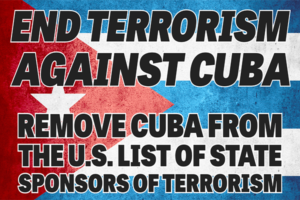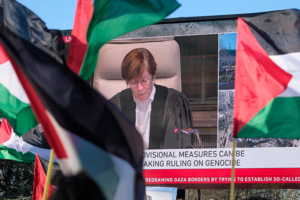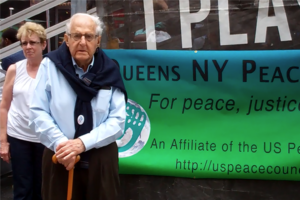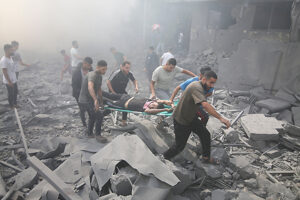Campaign Against Sanctions and Military Actions in Iran
Introduction
The current U.S. standoff against Iran, like the run-up to the invasion of Iraq in 2003, was instigated by the neoconservatives of the Bush Administration based on their doctrine of “maintaining U.S. pre-eminence, thwarting rival powers and shaping the global security system according to U.S. interests”. In the case of Saddam’s regime, its fictitious Weapons of Mass Destruction (WMD) and its alleged links to Al-Qaida were used in the U.S. propaganda war to first impose U.N. sanctions and eventually invade Iraq. We now have a déjà vu situation in which the U.S. and its allies, prodded by Israel, demonize Iran as a threat to world security and accuse it of having a program to develop nuclear weapons. As with Iraq, the real aim is a regime change in Iran to set up a U.S. puppet government in this oil- and gas-rich country in the key strategic Persian Gulf region. This has also happened before in the 1953 U.S.-British coup in Iran. The same forces in U.S., U.K., Israel and allies today distort the truth and engage in deceit, coercion and aggression to achieve their goals. We will briefly examine some of the key facts in the standoff.
Iran has the right to develop nuclear technology for peaceful purposes.
Iran was among the first of 190 countries to sign the Nuclear Non-Proliferation Treaty (NPT) in order to “prevent the spread of nuclear weapons and weapons technology and to promote cooperation in the peaceful uses of nuclear energy and to further the goal of achieving nuclear disarmament and general and complete disarmament. The Treaty represents the only binding commitment in a multilateral treaty to the goal of disarmament by the nuclear-weapon States”. As a party to the NPT Iran has an “inalienable right” to develop and use nuclear energy for peaceful purposes.
The NPT further requires that all parties to the treaty should help other members wishing to develop nuclear technology for peaceful purposes. But Western pressure has blocked Iran’s access to such cooperation, forcing the country to strive for self-reliance in nuclear technology.
There is no evidence that Iran is developing nuclear weapons.
The U.S. now nominally recognizes Iran’s legal right under the NPT to develop nuclear technology for civilian use, but charges that Iran’s nuclear program is a cover for developing nuclear weapons. There is absolutely no proof to back up this charge. Thousands of hours of United Nations inspections by the International Atomic Energy Agency (IAEA), the most intensive and intrusive ever undertaken in its history, have not produced one shred of evidence of nuclear weapons planning in Iran. Every IAEA report on Iran to date, including that of May 31, 2010, has stated that the “Agency continues to verify the non-diversion of declared nuclear material in Iran”.
Nuclear power plants and atomic weapons both require enriched uranium. But militarization requires uranium enriched to very high degree (above 90%), unlike “low-enriched uranium” (LEU) suitable for power plants (up to 5%) or for medical applications (up to 19.75%). And yet the U.S. demands that Iran terminate its enrichment process altogether, in essence denying Iran its inalienable right to pursue civilian nuclear technology under the NPT.
Further, Western leaders and media often quote from the IAEA reports that “Iran has not provided the necessary cooperation to permit the Agency to confirm that all nuclear material in Iran is in peaceful activities. However they never mention in public that this kind of arbitrary accusation is applicable also to dozens of other NPT members, including South Africa, Egypt and Brazil, that have not agreed to the optional NPT Additional Protocol to allow extra-intrusive inspections.
The U.S. and its allies have singled out Iran and demand that Iran prove it is not intent on developing nuclear weapons now or in the future. That is a logical impossibility, like when the U.S. demanded that Iraq prove it was not making weapons of mass destruction; charged Iraq with fabricated evidence that it had purchased “yellow cake” uranium powder from Niger; and that it had links with Al-Qaeda. Nothing Iraq said or did could stop the 2003 catastrophic invasion of that country – after which the U.S. had to admit that the charges were false.
In an exact replica of the run-up to the invasion of Iraq, the U.S. and its allies now allege that Iran has engaged in “nuclear weaponization studies,” but have even refused to hand in their alleged evidence to the IAEA so Iran can investigate them and give a response. Iran has insisted categorically that these documents are fabricated and are forgeries.
Iran’s need for nuclear energy and technology is real.
Iran’s population has more than doubled in three decades and its per capita energy consumption has grown even faster. Demand has outpaced production so much that electricity is rationed with rotating scheduled cuts in Tehran during peak periods of summer heat, and in July 2010 most public sector agencies in 20 of Iran’s 30 provinces are shut down intermittently for conservation. So the country needs to diversify its energy sources to keep up with demand and still have enough oil and gas for export and for future generations. This need was recognized years before the 1979 Revolution, when Iran, under prodding from the U.S. government which was acting in the interests of U.S. energy-related companies such as General Electric and Westinghouse planned multiple nuclear power stations.
Iran’s dependency on Western-dominated global markets, as well as on the refining and importation of petroleum products, make Iran vulnerable to foreign economic warfare. Iran has the largest fleet of oil tankers in the Middle East, but these ships are easy targets for attack or sabotage.
It is in Iran’s legitimate security interest to develop alternatives to oil for domestic consumption. With global oil derivatives such as gasoline and petrochemical items shrinking in availability and increasing in price, Iran truly needs to reduce its dependency on imports.
Iran’s need for nuclear technology is not limited to economic and security aspects. The country also needs nuclear fuel for its medical purposes. The Tehran Research Reactor (TRR), which produces isotopes for the treatment of more than 800,000 cancer patients and people with other complicated diseases, is running out of fuel this year. More has to be produced by Iran itself, because not only the half-life of the radioisotopes used by the TRR is too short to be imported from other countries but also because the U.S. and its allies have a history of blocking Iran’s right to purchase fuel for the TRR from the international market.
All these considerations fully justify the urgency of Iran’s civilian nuclear program.
UN Security Council’s involvement and sanctions against Iran are illegitimate.
Since there has never been any evidence of a nuclear weaponization program in Iran and because Iran has cooperated with the IAEA, the two votes in 2005 and 2006 in the Governors’ Board of the IAEA to report Iran’s nuclear file to the U.N. Security Council (UNSC) were coerced and politicized moves that were legally untenable, as explained by a leading international lawyer. – Therefore, the UNSC’s imposition of sanctions on Iran violates the IAEA’s own statute and lacks legitimacy.
The process that led to the UNSC’s involvement also was flawed because, under Western pressure, the IAEA’s expectations of Iran exceeded NPT’s Safeguards requirements. To boost confidence in its nuclear program during the course of two years of negotiations with the EU3 (France, U.K., Germany) , the Iranian government voluntarily suspended its nuclear enrichment program and in December 2003 also voluntarily implemented the IAEA’s Additional Protocol that allows more intrusive inspections than those required under the NPT. However, under U.S. pressure, Iran received nothing in return and a new administration decided to resume the enrichment program and dropped its adherence to the Additional Protocol.
When the public is told that Iran did not disclose the construction of a new enrichment facility in Qom, it is important to remember that the expectations would be valid only if Iran were still bound by the optional Additional Protocol. Under the NPT, Iran was only required to disclose the facility six months before it intended to introduce uranium fuel. In fact, it did so 18 months in advance, but still was accused of violating its international responsibilities under the NPT. Iran has offered to implement the Additional Protocol again if its file is returned from the Security Council to the IAEA.
The politicized nature of the IAEA’s referral of Iran’s case to the UNSC and the resulting sanctions is evident in the support by the U.S. for Israel’s open secret “nuclear deterrence” and the fact that U.S. allies South Korea and Egypt were not punished after revelations in 2009 that they had experimented with near-weapons-grade nuclear material.
Iran is not a threat to the U.S.
In order to justify depriving Iran of nuclear technology, many U.S. political figures portray the Iranian leadership as irrational and hell-bent on using nuclear weapons as soon as they can develop them. But Iran has not attacked any country in more than 200 years and its military spending per capita is among the lowest in its region. On the contrary, it is Iran that has been attacked on many occasions, including an Iraqi invasion in 1980 which led to eight years of full-scale conflict at the cost of hundreds of thousands of Iranian lives. Iraq used chemical weapons during its Western-backed invasion of Iran, but Iran never retaliated in kind.
In fact, Iran’s Supreme Leader, Ayatollah Ali Khamenei, has issued a fatwa (religious decree of the highest order) banning the production, stockpiling and the use of nuclear weapons and any other weapons of mass destruction as anti-Islamic. He has reiterated this fatwa in his message to the Nuclear Disarmament and Non-Proliferation Conference in Tehran in April 2010.
On the other hand, the U.S. and Israel with vastly superior military capabilities, including massive nuclear arsenals, and U.S. military bases in most of the countries around Iran and a constant naval presence off the southern coast of Iran, constantly threaten Iran with military attack and destruction.
Iran is under constant threat of illegal foreign intervention.
All leading U.S. politicians, including President Obama, have stated that in dealing with Iran “all options are on the table,” which is the code phrase for threatening Iran with military intervention, including a nuclear attack. The new Nuclear Posture Review of the United States singles out only one non-nuclear armed country, namely Iran, as a possible target for American nuclear attack. Israeli officials have also threatened to launch war on Iran.
The U.S. has funded anti-Iranian terrorist groups both in and outside Iran and has itself engaged in kidnapping and sabotage operations inside Iran in direct violation of that country’s sovereignty. Under the Obama administration, the U.S. has intensified its covert military operations in Iran.
In addition, the U.S. government annually spends millions in public funds in anti-government propaganda operations directed at Iranians. All these are violations of the Article 2 of the U.N. Charter, which calls for respect of national sovereignty and forbids member countries from threatening or using force against other countries. U.S. interference in Iran’s internal affairs also is specifically banned by the bilateral Algiers Accord of 1981.
The 2009 Iranian presidential election and its aftermath are being exploited by pro-war forces
Many Western commentators point to the disputed 2009 Iranian elections and claim that, since there is a domestic opposition to the Iranian government, Iranians would support foreign intervention or an attempt at regime change. This is false and disingenuous. No opposition figure in Iran has ever asked for any kind of war, sanctions or even monetary help from outside the country.
While the idea of “targeted” sanctions may have some currency among a minority of exile-based Iranians, it is strongly opposed by the overwhelming majority of Iranians in general. There were reports of similar “popular support” for threats and “smart” sanctions against Iraq by exile groups like Ahmad Chalabi’s Iraqi National Congress. Those claims were cynically cultivated by the U.S. and British neoconservatives to justify their drive toward war.
The Obama Administration has backtracked on its own engagement pledge and now actively opposes peaceful solutions.
Barack Obama’s presidential campaign included promises to move U.S. policy away from confrontation with Iran and toward “direct and unconditional negotiations.” Disappointingly, the Obama administration has backed away from that position. Its current policy is virtually the same as that of the Bush/Cheney administration: i.e., before there can be any negotiations, Iran must first give up its nuclear program altogether.
Washington’s intransigence under the Obama administration is most evident with regard to the Iranian nuclear fuel swap proposal in May of 2010. Before the Iranian Revolution of 1979, Iran received U.S. assistance under the Atoms for Peace program to build a nuclear research reactor in Tehran.
As previously stated, the Tehran Research Reactor (TRR) is used for producing medical isotopes for the treatment of some 800,000 cancer patients. The reactor is fueled with uranium enriched to a higher degree than fuel needed for a nuclear power plant, but still far below the level required to build a nuclear weapon. That reactor is now running out of fuel.
In the fall of 2009, the Vienna Group (U.S., France, Russia and the IAEA) proposed that Iran swap 1,200 kilograms of its low-enriched uranium (LEU) for fuel rods with the higher-enriched uranium needed to fuel the TRR. Iran accepted this offer in principle, but insisted on guarantees to ensure it would actually receive the fuel rods. The Obama administration walked away from the negotiating table, adopting a “take it or leave it” position.
Iran, on the other hand, emphasized its readiness for more negotiations over the fuel swap proposal. Turkish Prime Minister Recep Tayyip Erdoğan and Brazilian President Luiz Inácio Lula da Silva stated their willingness for mediating the Iranian nuclear swap deal in a meeting with President Obama during the Nuclear Security Summit in New York in April 2010. Accordingly, President Obama stated in a letter to President Lula that, for the U.S., “Iran’s agreement to transfer 1,200 kg of Iran’s low enriched uranium (LEU) out of the country would build confidence and reduce regional tensions by substantially reducing Iran’s LEU stockpile.” President Obama further stated that “this element is of fundamental importance for the United States. For Iran, it would receive the nuclear fuel requested to ensure continued operation of the TRR to produce needed medical isotopes and, by using its own material, Iran would begin to demonstrate peaceful nuclear intent.”
On May 17, 2010, after 18 hours of negotiations in Tehran, Turkey, Brazil and Iran signed a third-country swap agreement (the “Tehran Agreement”) in which Iran compromised in every area it considered vital to its interests along the lines that President Obama had mentioned in his letter. And yet, regardless of initial support for the Iran-Turkey-Brazil Agreement, President Obama decided to dismiss the Tehran Agreement and push for a new round of sanctions against Iran in the UNSC. This fourth round of UNSC sanctions was thus imposed against Iran while Turkey and Brazil cast negative votes and Lebanon abstained.
The sanctions policy is deeply flawed, as well as counter-productive.
The stated goal of what are now four sets of Security Council-imposed sanctions as well as unilateral sanctions imposed by the U.S. is to pressure Iran to abandon its nuclear program. In reality, the sanctions are meant to promote “regime change” in Iran.
This policy is not only criminal, but also flawed. People rarely engage in anti-government activity when their countries are threatened, as shown by the examples of both Cuba and Iraq, as well as the 1.5 million Palestinians living in the Gaza Strip. With Iraq in particular, sanctions resulted in a genocidal level of civilian casualties, but still did not produce the intended results.
Sanctions are a gateway to war.
Sanctions are not only a form of warfare but they can also lead to actual war. The only way to make sanctions viable would be to impose a total military blockade of all Iranian trade and forcefully intercept Iranian shipping. By any definition, that would be an act of war.
In retrospect, many Iraqis now see the sanctions of the 1990s not simply as “pressure” designed to force Iraq to end its non-existent WMD program, but as a cynical ploy to physically disrupt and weaken Iraq for an eventual military action. Those sanctions did succeed – costing the lives of 1.5 million civilians, including at least a half-million children.
The U.S. and Israeli advocates of sanctions are fully aware of the clear and direct risk of war. Indeed, some of the most vocal advocates for sanctions are the same ones who promoted the 2003 illegal invasion of Iraq.
A catastrophic war or a peaceful resolution of the stand-off?
From the standpoint of the neoconservatives, sanctions on Iran must lead to a U.S. or Israeli military strike on Iran. This is a direct and gross violation of the U.N. Charter, which forbids military aggression on another country.
Further, the Iranian government has vowed to respond to any attack with full force. Many analysts warn of a quick chain reaction that could lead to a devastating regional war, from Afghanistan to Gaza, as Iran and its regional allies would retaliate against the U.S., Israel and their allies, resulting in unprecedented human and economic costs for both the region and the interfering forces.
A peaceful resolution of the conflict can only be achieved by rejecting the current illegitimate course of threats and sanctions. The U.S. policy of aggression should be replaced with unconditional and comprehensive negotiations between Iran and the U.S. based on mutual respect to build trust between the two sides and to find a solution to the standoff that recognizes Iran’s sovereignty and national rights.
Campaign Against Sanctions and Military Intervention in Iran (CASMII)
September 10, 2012
___________________





